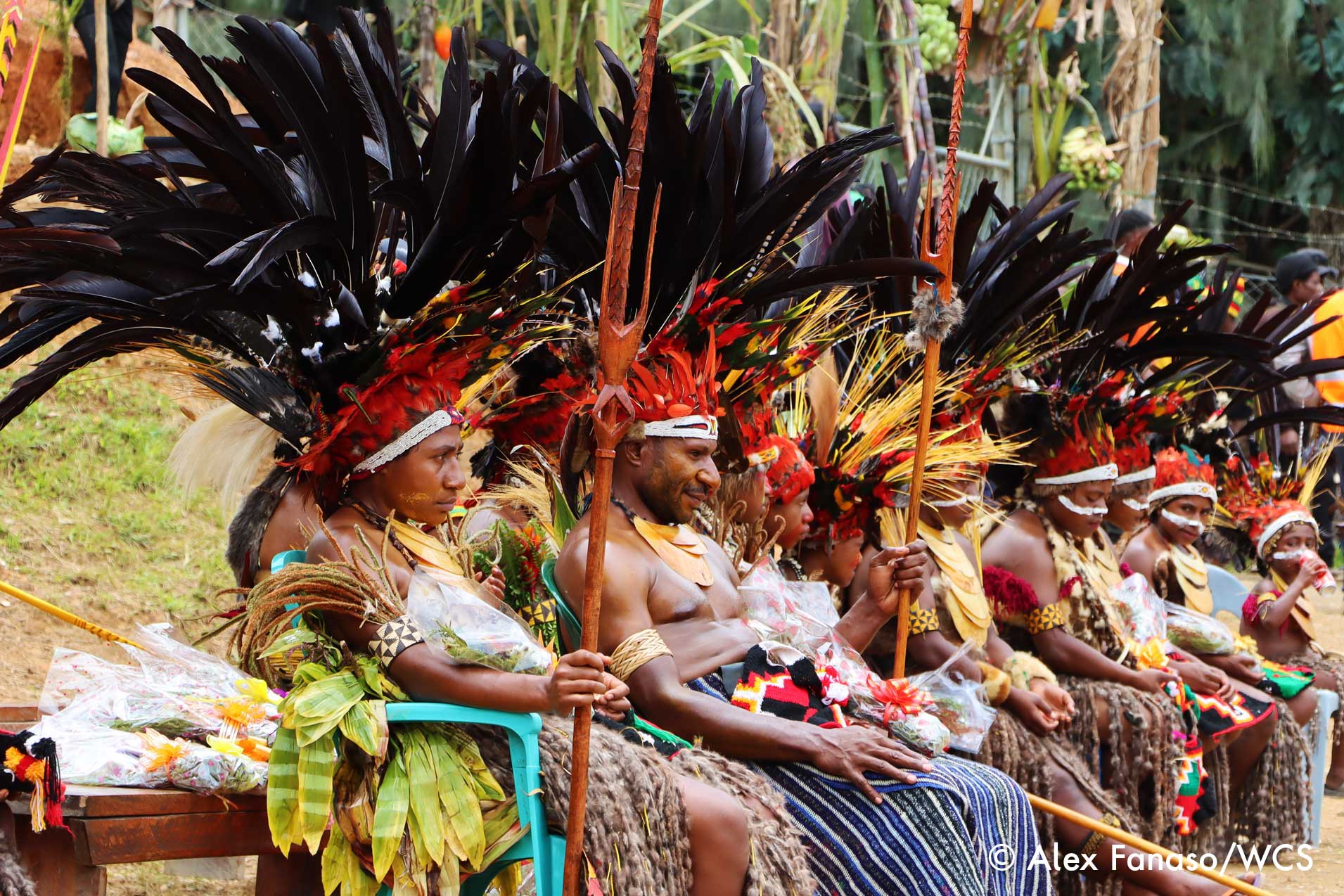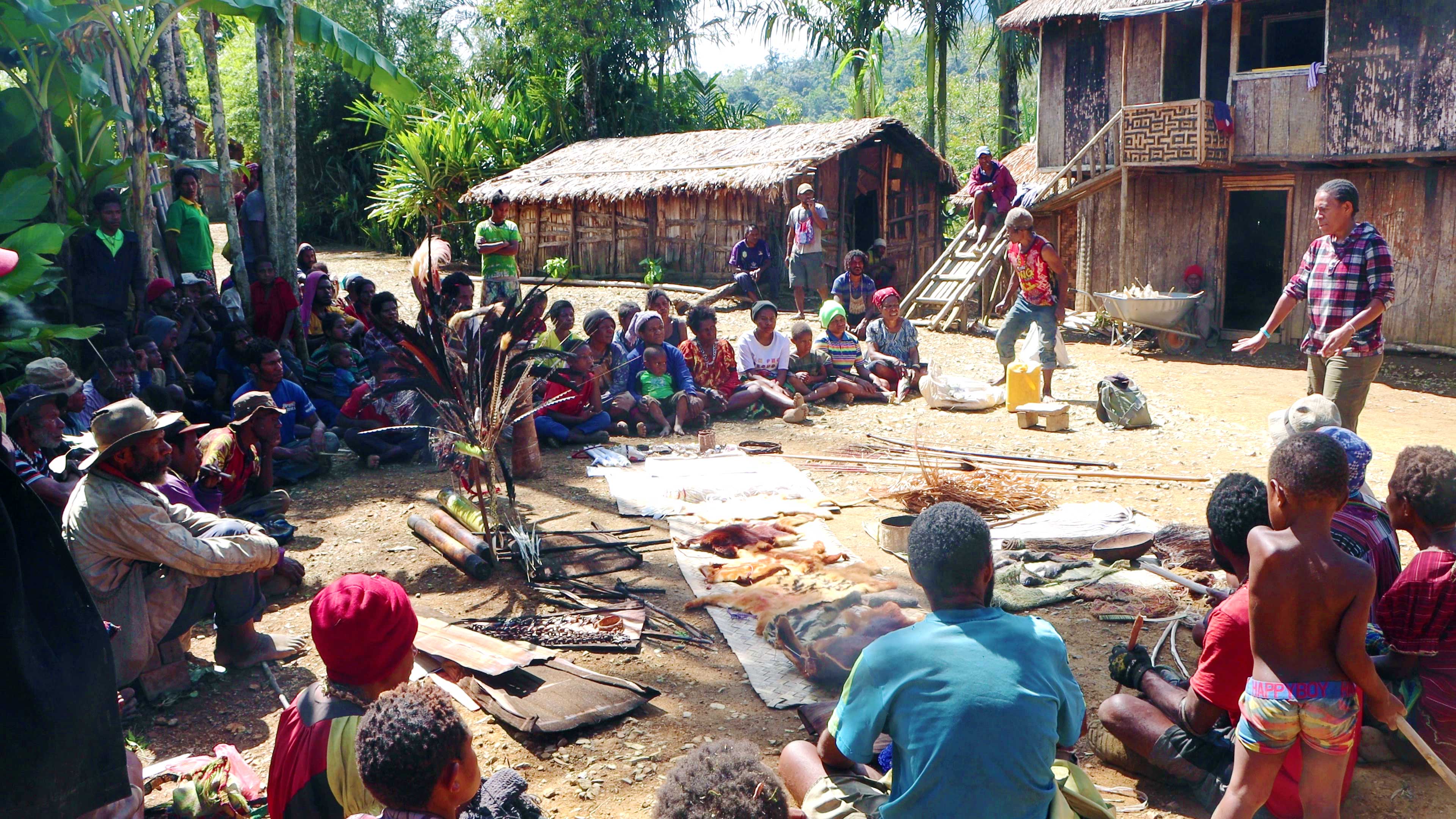
An interview with Azalea Anota, Program Officer at the Wildlife Conservation Society (WCS) in Papua New Guinea (PNG) by the National Newspaper (PNG).
From your point of view as a conservation organization, do you think there is over-hunting for traditional bilas? If so, is this a concern and, how serious is this?
In PNG, hunting targets small wild animals. It is not as frequent an activity as what ‘hunting’ would be considered in Africa or South America. Over-hunting is when an animal is captured or killed in excess of its reproductive rate, which leads to the serious reduction of that species’ population or even extinction. A recent surge in the demand for bilas ownership has raised its commercial value, increasing the quantity of wildlife hunted. In this way hunters are encouraged to hunt for wildlife to sell either dead or alive. To understand whether wildlife is over-hunted, a simple observation can be made by understanding a hunter’s effort in the forest. For example, if a hunter or forest owner decides to catch a cuscus, but it takes him the whole week to sight one or catch one covering a great distance, then this information provides details of a hunter’s effort. This can mean the cuscus population is declining and confined to the deep forest only, so the hunter must walk several kilometers to catch one. Today, an increasingly large number of animals used for bilas are becoming hard to catch in the forest. This suggests over-hunting is becoming a looming threat for wildlife, along with climate change and land-use change. If hunting activity continues without proper awareness and regulatory approaches, Papua New Guinea’s Bilas tradition will sadly become another dead folklore.
What type of animal is more at risk, with regards to hunting for traditional bilas? And is it possible to minimize the danger to these animals? If so, how?
In the highlands, bird feathers and fur from tree climbing marsupials (tree kangaroos and cuscuses) are commonly used in traditional bilas. Of the various species found in the traditional ornamentation, the Vulturine parrot, Psittrichas fulgidus (IUCN: Vulnerable) and the Goodfellow’s tree kangaroo, Dendrolagus goodfellowi (IUCN: Endangered) are at high risk of extinction in the wild because of their demand. If there is no conservation effort to protect these species, they will become extinct in the wild. This means they will not be found in the wild but only in captivity (e.g. zoo). The ‘Conservation and Environment Protection Authority’ is the government regulatory body responsible for monitoring wildlife conservation and natural resource use in PNG, and for enforcing conservation policies. At the local level, there are four simple behavioral changes people can do to protect bilas wildlife: 1) Do not hunt, capture and sell Endangered (e.g. Good fellow’s tree kangaroo), Critically Endangered (e.g. Long-beaked echidna), Vulnerable ( e.g. Nuigini Harpy eagle, Vulturine parrot) and Near Threatened (e.g. Dwarf cassowary) animal species; 2) Do not hunt or capture female animals, especially marsupials with babies in their pouch; 3) Do not buy dead or live wildlife sold in towns and markets as you will only encourage hunting activities; and 4) Avoid modern hunting tools such as snares and nets, guns, slingshot and the use of dogs when hunting. These tools increase lethality because of the improved precision and minimum effort required in capturing the animal.
 Azalea Anota Doing awareness of Bilas Kit in Kubam, Jimi District in Jiwaka Province. Photo © Alex Fanaso/WCS
Azalea Anota Doing awareness of Bilas Kit in Kubam, Jimi District in Jiwaka Province. Photo © Alex Fanaso/WCS
Do you have any statistics to show the decrease of these “at risk” animals over the years? What other activities affect the same species of animal mentioned above?
WCS has been monitoring wildlife distribution in the Bismarck Forest Corridor since 2017 and is in the process of gathering data on the population trends of animals used for bilas. However, the concern expressed by local forest owners and hunters of the difficulty in capturing and even seeing the Goodfellow’s tree kangaroo in the wild is a telling sign. The Vulturine parrot is found in the lowlands restricted to 500–1800 m in elevation (Mack and Wright 1998) and the rate of exploitation of this species for bilas shows that it is unsustainable (Nugi and Whitmore, 2019). This can be compounded by the increased forest exploitation for agricultural purposes to meet the demand of the increasing human population at the expense of the species’ habitat.
Forest exploitation also increases the spread of invasive species and pushes wildlife toward a survival point of no return (by affecting habitat, population/breeding, feeding and migration), beyond which, even if left alone, the population of a species will decline toward extinction. Additional natural threats to the natural wildlife, such as climate change, forest bush fires, and spread of invasive species by natural agents (wind, animals and water) only worsens the situation.
What message do you wish to disseminate to the people, through the media, with regards to conservation?
Our cultural diversity exists because of the wildlife diversity in our forests, land and seas. All the wildlife in our forests and land are becoming increasingly hard to access because of two main contributing factors, over-population and climate change. Wildlife needs time to repopulate, grow and rebuild the ecosystems and human activities are preventing this to occur. In order to help the forest and land rebuild itself, communities should work together to protect their forest through conservation efforts with strict and enforceable rules suited to their geography. Such conservation tools include the Conservation Deed and Natural Resource Management Plan rules. The reforestation of degraded forest with native trees to bring back the forest is the most simple and beneficial conservation effort. Some conservation rules can be developed around harvesting enough natural resource based on taking only what you need, harvesting plants not by uprooting, replacing a felled tree with a new tree, avoid hunting female marsupials with babies in their pouches, and avoid using dogs and guns when hunting. By managing the use and access to forest resources, we are encouraging our wildlife to regenerate with increased forest cover for future generations to have access to and enjoy.
What program are you working on for this year?
WCS has developed simple, cost effective bilas protection kits to help prolong the lifespan of bilas. These are given to communities we work with and are distributed during cultural shows in the region for protective covering. It is important for bilas owners to properly store their existing bilas to avoid the need to frequently replace damaged bilas, which leads to increased hunting. A ‘Bilas Protection Kit’ consists of strong plastic sheets, plain butcher paper, naphthalene balls and an instruction pamphlet. In this way, WCS hopes to encourage bilas owners to properly protect their bilas an activity we will continue this year. In line with that, the main conservation activity for WCS, is focused on working with communities in protecting their natural resources by assisting them in developing community natural resource management plans through land use planning. This is a tool used to assist natural resource owners identify and develop conservation management plans to protect their forest and natural resources. WCS facilitates this process that includes the development of rules by the community, on how to use their natural resources in a protected area, with the support from the European Union Sustainable Wildlife Management Programme and the USAID PNG Lukautim Graun Program.
Anything else you wish to add regarding your work or generally on conservation?
The local people have very strong connections to their natural environment. Conservation in PNG is about the thriving of the local people on how and from where they source their food, medicine and traditional bilas, to name a few. Regardless of the origin of the term, in PNG, ‘Conservation’ means protecting our way of life.
Useful references:
Grace Nugi & Nathan Whitmore (2019): More dead than alive: harvest for ceremonial headdresses threatens Pesquet’s Parrot in Papua New Guinea, Emu - Austral Ornithology IUCN. (2001). IUCN Red List Categories and Criteria: Version 3.1. IUCN Species Survival Commission. IUCN, Gland, Switzerland and Cambridge, UK. ii + 30 pp. Mack, A. L., and Wright, D. D. (1998). The Vulturine Parrot, Psittrichas fulgidus, a threatened New Guinea endemic: Notes on its biology and conservation. Bird Conservation International 8, 185–194. doi:10.1017/S0959270900003257